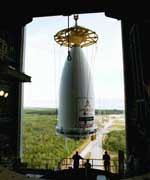Ice particles are key players in the ever-changing panorama at Saturn, according to a new study led by a University of Colorado at Boulder professor using an instrument on the Cassini-Huygens spacecraft now at the ringed planet.
Larry Esposito of the Laboratory for Atmospheric and Space Physics said data from the Ultraviolet Imaging Spectrometer, or UVIS, indicates much of Saturn’s system is filled with ice, as well as atoms derived from water. Esposito is the principal investigator for the $12.5 million UVIS instrument riding on the craft.
Esposito said hydrogen and oxygen atoms are widely distributed in the planetary system, which extends millions of miles outward from Saturn. Cassini researchers are seeing large fluctuations in the amount of oxygen in the Saturn system, he said.
“A possible explanation for the fluctuation in oxygen is that small, unseen icy moons have been colliding with Saturn’s E ring,” said Esposito. “The collisions may have produced small grains of ice, which yielded oxygen atoms when struck by energetic, charged particles in Saturn’s magnetosphere. UVIS is able to identify these glowing atoms.”
A paper on the subject authored by Esposito and colleagues appears in the Dec. 16 issue of Science Express, the online version of Science magazine. Esposito also will give a presentation on the new results from the Cassini-Huygens mission at the Fall Meeting of the American Geophysical Union, being held this week through Friday in San Francisco.
Saturn’s ring particles may have formed originally from pure ice, Esposito said. But they have since been subjected to continual bombardment by meteorites, which has contaminated the ice and caused the rings to darken.
Over time, incessant meteorite bombardment has likely spread the dirty material resulting from the collisions widely among the ring particles, he said. But instead of uniformly dark rings, the UVIS instrument is recording “radial variations” that show brighter and darker bands in the individual rings.
“The evidence indicates that in the last 10 million to 100 million years, fresh material probably was added to the ring system,” he said. The research team proposed that such “renewal events” are from the fragmentation of small moons, each probably about 20 kilometers (12 miles) across.
“The interiors of the tiny moonlets, which have been shielded from contamination by the continual collisions with each other, are the source of purer water ice,” he said. “Both the oxygen fluctuation and the spectral variation in Saturn’s rings support a model of ring history in which small moons are continually destroyed to produce new rings.”
The ice grains released by the continual moonlet collisions are bathed by Saturn’s radiation belt, liberating the oxygen atoms that are seen by UVIS in the ultraviolet as they reflect sunlight in the immense cloud surrounding Saturn, said Esposito.
Other authors on the Science Express paper include LASP’s Joshua Colwell, Kristopher Larsen, William McClintock and Ian Stewart. Researchers from the University of Southern California, NASA’s Jet Propulsion Laboratory, Central Arizona University, the California Institute of Technology and the Max Planck Institute and Stuttgart University in Germany also co-authored the paper.
Launched in 1997, the Cassini-Huygens spacecraft achieved Saturn orbit June 30. During the spacecraft’s four-year tour of the Saturn system, the UVIS team will continue to track the dynamic interactions of the planet’s rings, moons and radiation belts, Esposito said.
The Cassini-Huygens mission is a cooperative project of NASA, the European Space Agency and the Italian Space Agency. The Jet Propulsion Laboratory, a division of the California Institute of Technology in Pasadena, Calif., manages the Cassini-Huygens mission for NASA’s Science Mission Directorate in Washington, D.C.
Original Source: UCB News Release

